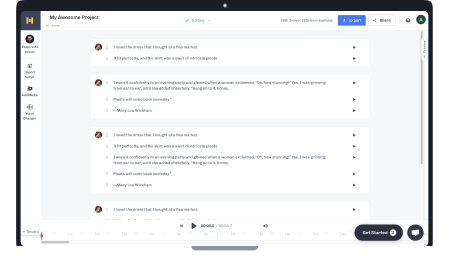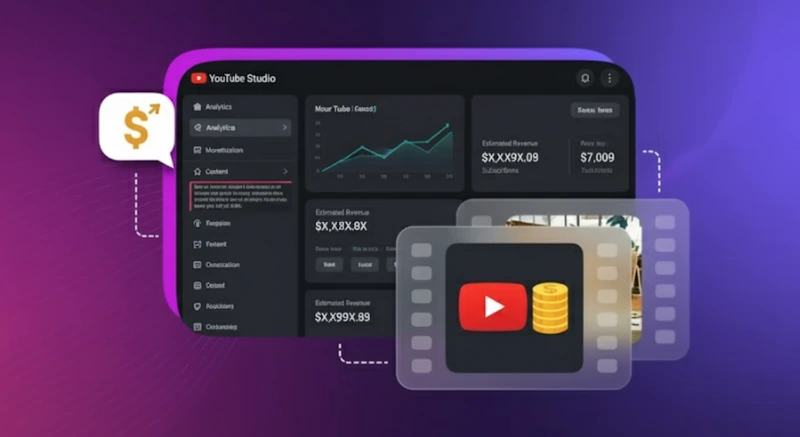How Much Do Twitch Streamers Make: Earnings & Sub Rates

Ever wondered how much money your favorite Twitch streamer actually makes when shouting over gameplay or chatting with viewers at 2:30 AM? The numbers might make your jaw drop.
While Twitch continues to be a mainstream entertainment platform, especially for younger audiences, it is now emerging as a reliable source of revenue for creators too.
And behind this money-making is a complex mix of donations, subscriptions, brand deals, and ad revenue streams. However, the path toward stable Twitch earnings isn't straightforward, to say the least.
Multiple revenue streams, varied monetization tiers, and complex payout policies can make it difficult for creators to maximize their Twitch stream income.
Both new and established creators from other platforms also need to understand how Twitch channels are evaluated for monetization. Most Twitch streamers simply focus on viewer count or follower count, but there's more to it.
In this article, let's look at how much do Twitch streamers make and how creators can maximize their organic Twitch revenue.
The Key Revenue Streams on Twitch
1. Subscriptions
Twitch subscriptions charge a monthly fee to a loyal audience base in exchange for various perks, which are determined by the creator. The perks can be an ad-free viewing experience, merch, or extended privileges during live streams.
There are three tiers, typically priced at $4.99, $9.99, and $24.99, attracting viewers from different market segments. 50% of the subscription revenue is taken by Twitch, and the rest is credited to the streamer.
Many Twitch streamers with larger audiences can negotiate a more favorable split with the platform to boost their income. Due to their recurring nature, creators can make money more reliably through this monetization method.
2. Bits of Cheers
Twitch Bits are a virtual currency that commonly costs $0.01 per Bit that viewers can spend to "cheer" their favorite creators. While it may seem like an insignificant amount, especially after the platform's 50% cut, it can add up over time to skyrocket how much streamers earn.
While creators can earn from Bits (and subscriptions) from day one, they need their Twitch Affiliate Status approved by the platform to receive payouts. This also collects tax information and is pivotal for compliance.
It is key for creators to focus on viewer engagement to maximize how much Twitch's virtual currency they can accrue.
At the same time, it is important to note that only top Twitch streamers can consider Bits as a main revenue stream, due to how much Twitch pays per unit of their virtual currency to creators.
3. Ad Revenue
Streamers can earn revenue by broadcasting promotional messages during their live shows to their concurrent viewers. Here, creators need to be in Twitch's Affiliate program or the Twitch Partner program to be eligible for earning ad revenue.
The live streaming platform uses a cost per mille (CPM) framework to pay the creators. Hence, the earning potential is closely tied to CPM optimization.
And so, it's key to choose the right niche or topic for live streams. Twitch attracts millions of dollars in ad revenue from companies in the gaming and tech industries. It is unsurprising that some of the most profitable Twitch accounts feature streamers who play video games or discuss technological innovations.
4. Donations and Tips
Over time, content creators earn loyal fans who support streamers by donating money. This monetization method gives almost the entire amount to the creator. The only cut is the processing fees. However, the downside here is that the amount earned through donations and tips can often fluctuate.
Twitch streamers can encourage tipping by broadcasting themed episodes (e.g., "upgrade my setup") and offering digital goodies like animated emotes. Moreover, they need to promote themselves on various social media platforms to keep their loyal audience engaged.
5. Sponsorships
Sponsorships refer to brand deals where the creator promotes the company's goods or services for payment. There are several ways Twitch's streaming community can approach this.
First, creators can review the offerings of a brand and share their feedback with a live audience. They can answer their questions to educate the audience.
Another effective sponsored content type is hosting live branded events and streaming them via Twitch.
This additional revenue stream works well if a creator has a sizable number of average viewers. It will, in a way, guarantee the sponsor a certain level of visibility, enabling the streamer to negotiate a better deal.
What to Expect: Twitch Earnings by Stage
1. Beginner: Few Viewers, Starting Out
At this stage, creators may have a handful of paying subscribers and limited concurrent viewers. This makes them a Twitch Affiliate.
Additionally, as the streamer is new, they may receive limited Bits, donations, and sponsorships. In many cases, it can be nil. However, it is to be expected, and the creator, at this level, should focus on enhancing viewer engagement over maximizing revenue.
Roughly, beginners on Twitch, as per their monetization service and community guidelines, can earn between $50 and $200 per month if they stream regularly and have consistent supporters.
2. Mid-Tier Streamer: 500 Concurrent Viewers
Once a creator starts to amass a few hundred viewers per live stream, their revenue increases significantly. They get more fans in each subscription tier, higher ad revenue, and Twitch Bits.
If they operate in profitable niches like technology and sports, they can even attract sponsors with small-to-mid-level deals. These partnerships may not be monetarily, but they boost the streamer's publicity.
Other brands will start to view them as a potential partner, opening more doors.
Overall, Twitch streamers at this stage can expect anything from $500 to $5000 per month, depending on factors like niche, consistency, and audience size.
3. Higher-Tier Streamer: 1000+ Concurrent Viewers
This is where a streamer's income from Twitch skyrockets in every way. Content creators in this category earn at least $5000 per month, and can easily go all the way above $50,000.
Here, the Twitch streamer usually has their built-in audience, enabling them to receive sizeable donations. In some cases, creators sell branded merchandise like t-shirts, which boosts revenue further.
Note that the growth from beginner to high-tier isn't linear or predictable. There can be instances where a streamer has a larger audience than others but fails to secure profitable sponsorship deals.
Similarly, there can be mid-tier streamers, in terms of viewer count, who might earn more revenue than a few high-tier streamers.
What Influences Twitch Earnings
1. Audience Size and Consistency
Average viewership has a central impact on every revenue stream. Moreover, they should consistently join every live stream. This builds brand affinity, turning them into loyal fans, which is key to boosting Twitch income.
Streams can optimize this by sticking to a topic and going live at a predictable time. Many creators prefer to share their broadcasting schedule beforehand with their audience to maximize peak viewership.
2. Engagement and Community Quality
More than providing entertainment or education, a streamer's goal is to create an environment where people can interact with each other about their favorite topics.
Let's say a content creator plays games online for their viewers. They can improve audience engagement and community quality by facilitating productive discussions. It involves responding to the live comments and chats while respecting differing opinions.
3. Content Niche and Genre
Popular topics help target larger audiences but can be quite competitive. On the other hand, niche subjects or genres offer limited monetization potential. Furthermore, the nature of the topic also determines audience demography, which impacts ad revenue directly.
There can be topics, like movies and politics, that may earn bigger average viewerships but offer limited sponsorship deals.
Therefore, creators should conduct thorough market research, such as analyzing other streamers' profiles and what's trending, to find a sweet spot.
4. Twitch Revenue Policies
Twitch's terms around monetization evolve with time. Currently, the platform takes a 50% cut of subscription revenue from its users, unless they are a top streamer.
The payout terms from advertisements are determined on a case-by-case basis. It depends on streaming hours, engagement levels, and ad placement (e.g., mid-roll ads, pre-roll ads, etc.).
Additionally, these policies can change. Many streamers take time to learn the nuances of these rules to target specific revenue streams. For instance, some creators prefer to maximize donations while others may choose to stick with subscribers' revenue.
Challenges While Earning on Twitch
Creators on their way to make money on Twitch may face the following roadblocks:
- Low success rate: Only a small percentage of creators on this live streaming platform ever qualify for the Twitch Partner program. At the same time, gaining traction can be quite difficult for entry-level creators.
- Evolving platform policies: Regulations around broadcasting and monetization constantly change. This can affect a Twitch streamer's earnings, whether positively or negatively, overnight.
- Non-linear growth: It's nearly impossible to predict when a small streamer will start to get tens of thousands of viewers consistently. This can lead to financial instability for creators and affect their commitment to building a career on this platform.
- Creator burnout: Constantly going live and interacting with an audience on a regular basis can be tiring. Beginners can feel exhausted and depleted, affecting creativity and performance. It is important to set the right expectations from the start and take breaks as needed.
How Twitch Streamers Can Increase Income With Murf AI

Murf AI is a leading voice cloning and AI dubbing platform that translates existing video, audio, and text into engaging voiceovers. Users can choose from 200+ voices across more than 30 languages to produce multimedia content for different geographies.
Twitch content creators can leverage this platform to localize their past content.
For instance, they can take a clip and dub it into a different language. This will enable them to reach larger audiences. The translated content can be distributed across other platforms like YouTube and Instagram to keep their audience engaged even when they aren't live.
Additionally, Murf AI’s powerful API and video translator can help Twitch creators change their voice instantly, enabling them to entertain their audience more.
The ethically crafted digital voices, coupled with accurate dubbing capabilities, can easily expand streamers’ reach, growing their brand faster.
Ready to boost your Twitch earnings?
Sign up today and get 10 free AI generation minutes.

Frequently Asked Questions
How Much Do Twitch Streamers Make Per Sub?
.svg)
Twitch streamers typically earn 50% of a Tier-1 subscription, which costs $4.99. That means about $2.50 per sub. Higher-tier subs (Tier-2 and Tier-3) generate more income, while top creators may negotiate a 70/30 revenue split.
What Is the Average Income for a Twitch Streamer?
.svg)
Average income varies widely. Small streamers may earn under $100 per month, while mid-tier streamers can bring in $1,000–$5,000. Top creators often make tens of thousands monthly through a combination of subscriptions, ads, donations, sponsorships, and merchandise.
Do Twitch Streamers Get Paid Monthly?
.svg)
Yes, Twitch streamers are paid monthly, provided they meet the minimum payout threshold of $50. Payments typically occur 15 days after the end of the month, with options including direct deposit, PayPal, or wire transfer, depending on location.
Who Is the Richest Streamer on Twitch?
.svg)
As of recent reports, Félix “xQc” Lengyel is one of the highest-earning Twitch streamers. Leaks suggested he earned millions annually from subscriptions, ads, and sponsorships. However, earnings fluctuate, and other top streamers like Ninja and Pokimane also rank highly.
How Much Do Twitch Streamers Make from Ads?
.svg)
Ad revenue depends on viewer count and CPM rates. On average, streamers earn around $3–$5 per 1,000 ad impressions after Twitch’s split. For small creators, this may mean only a few dollars monthly, while larger streamers can earn thousands.







.webp)






